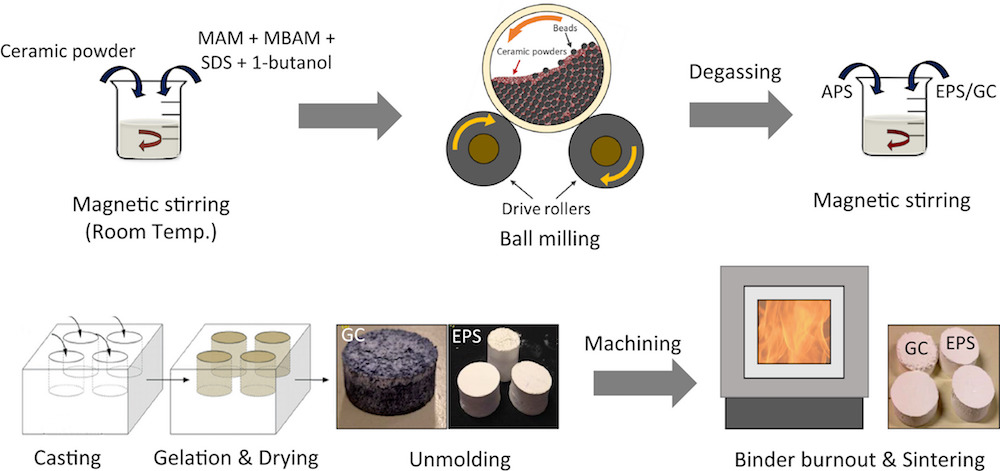
[Image above] Publishing sound science can take place at all stages of the research process. Credit: Daniel Mietchen, Wikimedia (CC BY 3.0)
With the launch of the International Journal of Ceramic Engineering and Science (IJCES), The American Ceramic Society has created new opportunities for publishing sound science and engineering.
What is meant by “sound science,” and how does the new journal fit in with our established journals? I use two recent articles on gel casting of porous ceramics published, respectively, in IJCES and in the International Journal of Applied Ceramic Technology (ACT) to illustrate these points.
Gel casting is a technique for net-shaping of ceramics with moderately complicated shapes. Ceramic powder is suspended in a polymer, which is poured into a mold and cured into a stiff gel. The gel is then burned out, often as part of the sintering profile. This technique creates relatively sturdy green bodies that are easily handled and can be green machined if needed.
Gel casting can be used to create porous ceramics. Porous ceramics have many applications from liquid metal filtration to health care. The two key parameters for porous ceramics are mechanical strength and open, interconnected porosity with consistent pore geometry. There are many ways to use gel casting to create porous ceramics, including using pore formers and direct foaming (creating stable air bubbles in the gelled polymer matrix).

The IJCES article “Porous alumina ceramics by gel casting: Effect of type of sacrificial template on the properties” is an excellent example of sound science and engineering. The researchers, from Luleå University of Technology and Akzo Nobel Pulp and Performance Chemicals in Sweden, explore different pore-formers for addressing multiple issues in the production of porous alumina products. Specifically, they explore whether they can improve the porosity and mechanical properties of an alumina product while reducing the carbon footprint during production.
The researchers compare an Akzo Nobel product (expanded polymer microspheres) to spherical glassy carbon of similar size. The science in their study is sound, meaning their work meets the following criteria:
- The materials and methods are well described,
- The data is sufficient to support the analysis and conclusions,
- The results are analyzed in the context of accepted interpretations and benefits to the field, and
- The literature references are relevant.
Their experiments each aimed to explore a specific parameter: shrinkage upon drying, binder burnout to study morphology, porosity and mechanical strength, and thermogravimetry with mass spectrometry for profiling the off-gassing of CO2.
The outcomes of the experiments indicated the expanded polymer microspheres show promise for all three parameters. The hollow microspheres improved pore shape. Their smaller mass minimized CO2 off-gassing which, while environmentally friendly, also reduces potential for defects and creates a stronger ceramic.
The paper, published in International Journal of Ceramic Engineering and Science, is “Porous alumina ceramics by gel casting: Effect of type of sacrificial template on the properties” (DOI: 10.1002/ces2.10013).
One key difference for this article compared to articles in the other ACerS journals is the depth and interconnectivity of the exploration and interpretations. The IJCES article researchers explored the parameters individually. While they demonstrated performance, the researchers did not make strong connections to underlying mechanisms. This does not diminish their excellent paper. Rather, it creates an opportunity for further study.
Compared to IJCES, articles in the other three ACerS journals are expected to provide well-evidenced connections among the data with explanations and mechanisms. A recent International Journal of Applied Ceramic Technology (ACT) article exploring gel-casting for creating dense and porous calcium phosphates provides an excellent example of an article with those rich interconnections and explanations.
In the ACT article, researchers from Politecnico di Torino in Italy weave together a singular story about the effects of particle size on the sintering of dense and porous samples. At each step in their study, they propose a mechanism and confirm it with subsequent experimentation or reference to prior studies; each subsequent step builds upon the previous step.
The researchers show that with these phosphates, starting with small particles that have a narrow distribution creates samples with superior microstructure and performance compared to using larger, broader powders. The narrow distribution leads to higher densities, both green and sintered. This leads to foams with nonporous struts that have the potential for greatly improving strength, which is important for bone replacement applications.
The paper, published in International Journal of Applied Ceramic Technology, is “Effect of dispersion on sinterability and microstructural development” (DOI: 10.1111/ijac.13184)
As you plan your experiments, simulations, and publications, consider your options for publishing at various stages of your research process. Do you have interesting results that you want to share quickly and globally? Have you developed the well-evidenced and well-referenced understanding of mechanisms underlying the observations? Matching your needs with the aims and scopes of each journal will greatly improve your article publishing experience.
For more information about the aims and scopes of the ACerS journals, check out the links below.
International Journal of Ceramic Engineering and Science (IJCES)
International Journal of Applied Ceramic Technology (ACT)
